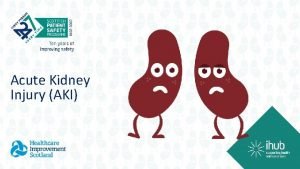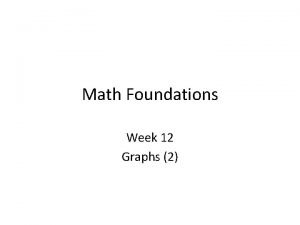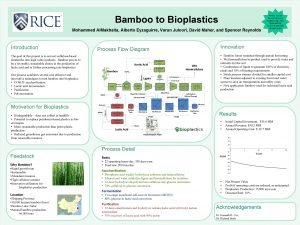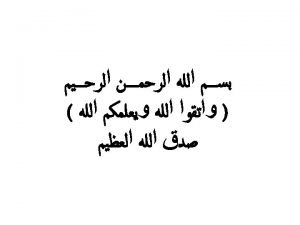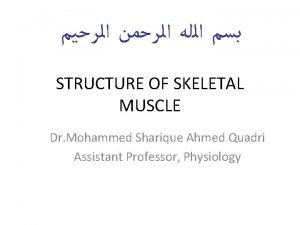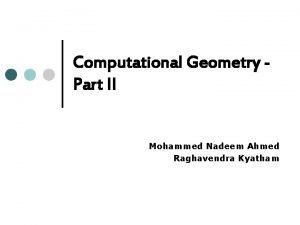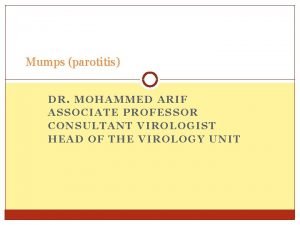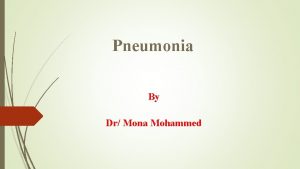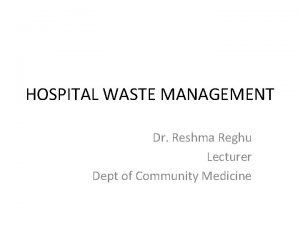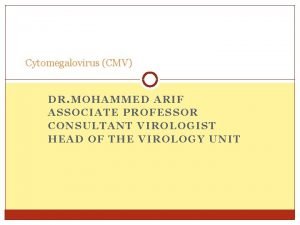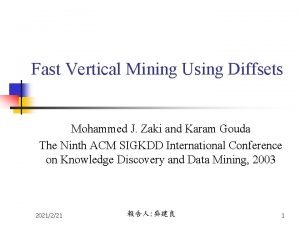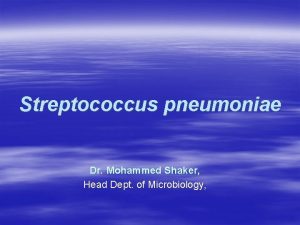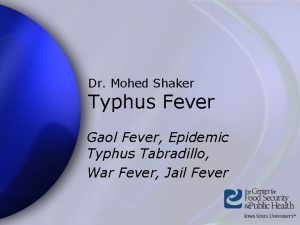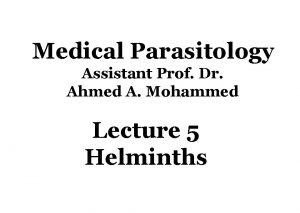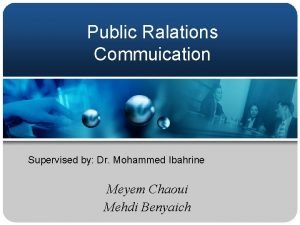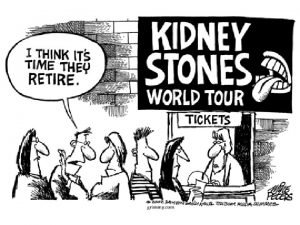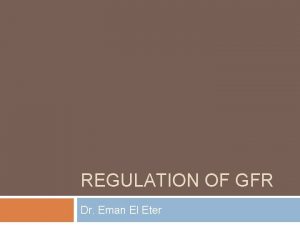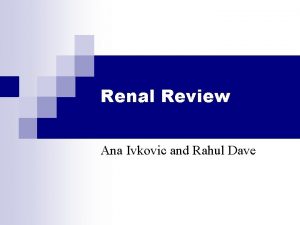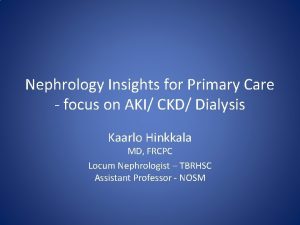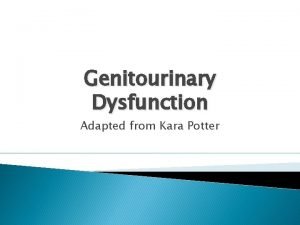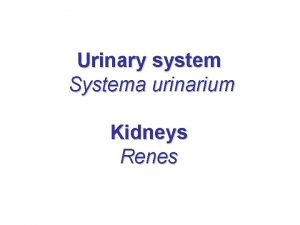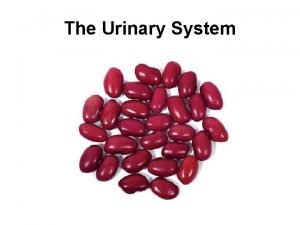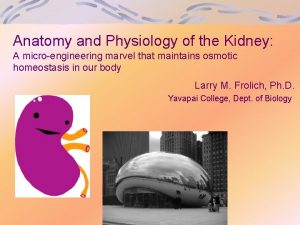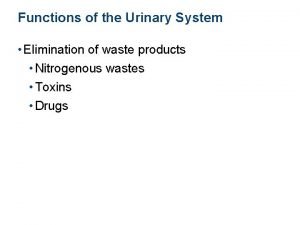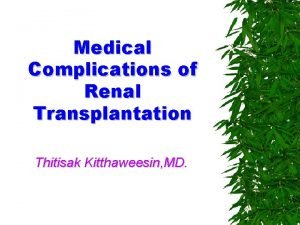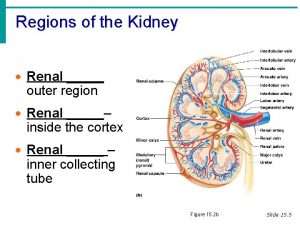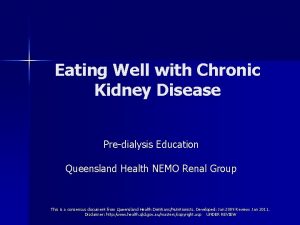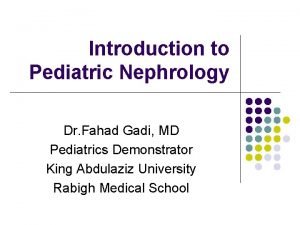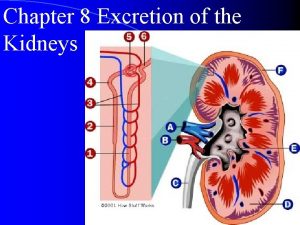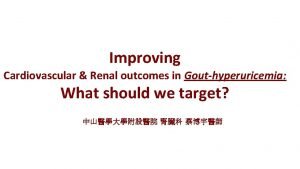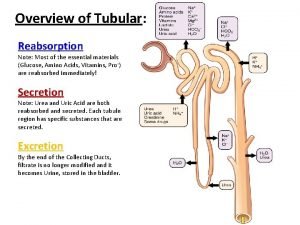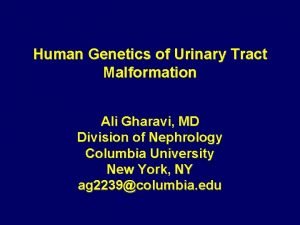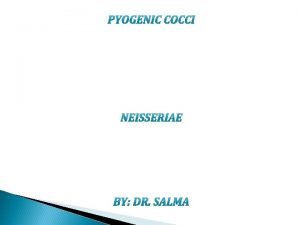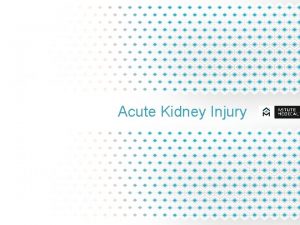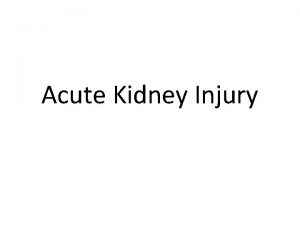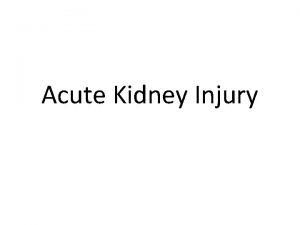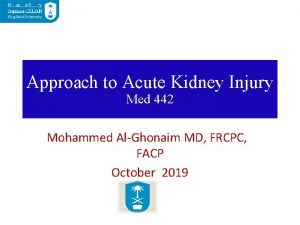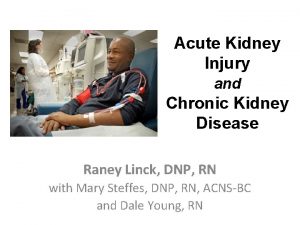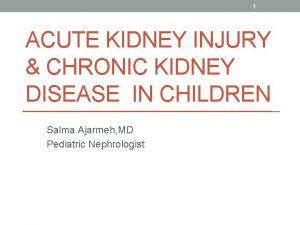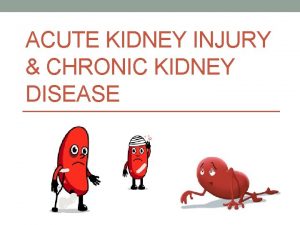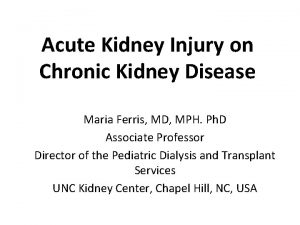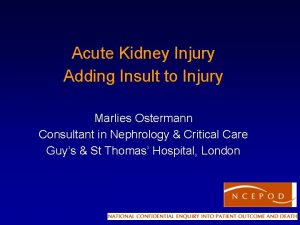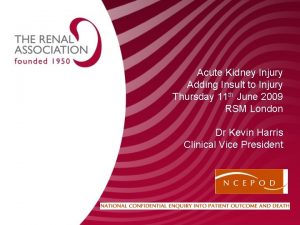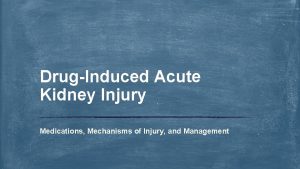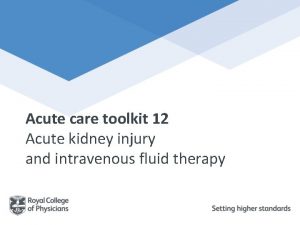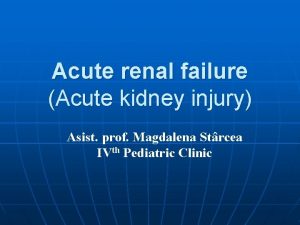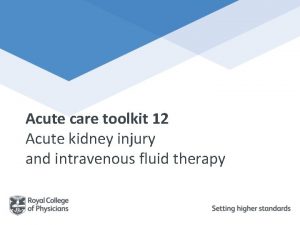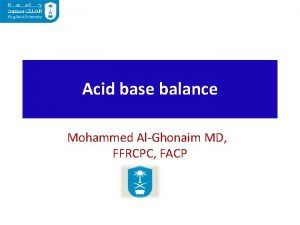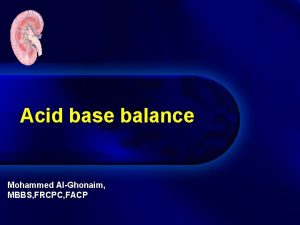Approach to Acute Kidney Injury Dr Mohammed AlGhonaim


































































- Slides: 66

Approach to Acute Kidney Injury Dr. Mohammed Al-Ghonaim MBBS, FRCP(C) November 2014

Objective • At the end of this tutorial you will be able to: – Define AKI – Know the epidemiology of AKI – Know the etiology of AKI – Manage AKI • Diagnose AKI • Treat AKI

Acute Kidney Injury (AKI) • Deterioration of renal function over a period of hours to days, resulting in – the failure of the kidney to excrete nitrogenous waste products and – to maintain fluid and electrolyte homeostasis • Oliguria: <400 ml urine output in 24 hours • Anuria: <100 ml urine output in 24 hours

Acute Kidney Injury (definition) • ARF in one study was defined as: – a 0. 5 mg/d. L increase in serum creatinine if the baseline serum creatinine was ≤ 1. 9 mg/d. L, – an 1. 0 mg/d. L increase in serum creatinine if the baseline serum creatinine was 2. 0 to 4. 9 mg/d. L, and – a 1. 5 mg/d. L increase in serum creatinine if the baseline serum creatinine was ≥ 5. 0 mg/dl

Acute Kidney Injury (AKI) • An abrupt (within 48 hours) absolute increase in creatinine by 0. 3 mg/dl (26. 4 µmol/l)or percentage increase of >50% from base line or urine output <0. 5 ml/hour for 6 hours

Definition: Acute Kidney Injury “Acute kidney injury, mortality, length of stay, and costs in hospitalized patients” 19, 982 pts admitted to academic medical centre in SF 9, 205 pts with >1 creatinine results Multivariable OR Rise in creatinine ≥ 0. 3 mg/dl (26. 4 μmol/L) (hospital mortality) 4. 1 ≥ 0. 5 mg/dl (45 μmol/L) 6. 5 ≥ 1. 0 mg/dl (90 μmol/L) 9. 7 ≥ 2. 0 mg/dl (180 μmol/L) 16. 4 Chertow et al. JASN 2005; 16: 3365 -3370

Stages: Stage Acute Kidney Injury Creatinine criteria Urine Output AKI stage I 1. 5 -2 times baseline OR 0. 3 mg/dl increase from baseline (≥ 26. 4 μmol/L) <0. 5 ml/kg/h for >6 h AKI stage II 2 -3 times baseline <0. 5 ml/kg/h for >12 h AKI stage III 3 times baseline OR 0. 5 mg/dl (44 μmol/L) increase if baseline > 4 mg/dl(≥ 354 μmol/L) OR Any renal replacement therapy given <0. 3 ml/kg/h for >24 h Mehta R et al. Crit Care 2007; 11(2): R 31 Ostermann et al. Critical Care 2008 12: R 144 OR Anuria for >12 h

Epidemiology • It occurs in – 5%of all hospitalized patients and – 35% of those in intensive care units • Mortality is high: • up to 75– 90% in patients with sepsis • 35– 45% in those without

Median hospital length of stay (LOS) stratified by single acute organ system dysfunction (AOSD), including acute renal failure (ARF).

Acute Kidney Injury Impact Correlation between AKI classification and outcome 22, 303 adult patients admitted to 22 ICUs in UK and Germany between 1989– 1999 with ICU stay ≥ 24 hours No AKI III 65. 6% 19. 1% 3. 8% 12. 5% 60. 5 62. 1 60. 4 61. 1 ICU mortality 10. 7% 20. 1% 25. 9% 49. 6% Hospital mortality Length of stay in ICU (median) 16. 9% 29. 9% 35. 8% 57. 9% 2 d 5 d 8 d 9 d Mean age Ostermann et al, Critical Care 2008; 12: R 144

Acute Kidney Injury Clinical outcome:

Etiology of ARF

Acute kidney injury Types and consequences: Pre renal Renal Post Renal Volume depletion Acute Tubular necrosis (ATN) Calcification Ureteric obstruction Decreased cardiac Acute interstitial nephritis (AIN Bladder neck obstruction Acute Glomerulonephritis (GN) Urethral obstruction output Clinical Consequences § Chronic Kidney disease § Hospitalization § End Stage Renal § Mortality Disease

Etiology of ARF

Pre-renal AKI – Volume depletion • • • Renal losses (diuretics, polyuria) GI losses (vomiting, diarrhea) Cutaneous losses (burns, Stevens-Johnson syndrome) Hemorrhage Pancreatitis – Decreased cardiac output • • • Heart failure Pulmonary embolus Acute myocardial infarction Severe valvular heart disease Abdominal compartment syndrome (tense ascites)

Acute Kidney Injury Scenario 1 75 years old female, known to have: – DM II – HTN • Presented with nausea, vomiting and diarrhea for 3 days • Medication: Insulin, lisinopril,

Scenario 1 Acute Kidney Injury Vital Signs Pulse Result 95/min Normal Range 60 -100/min Blood pressure 112/67 mm. Hg 130/80 mm. Hg Temperature 37. 0°C 36. 6 -37. 2°C Jugular venous pressure was low, dry mucus membrane Cardiovascular examination: Normal first and second heart sound no added sound or murmurs. Respiratory system examination: Lungs are clear to percussion and auscultation Abdominal examination: No tenderness, liver and spleen were not palpable.

Scenario 1 Acute Kidney Injury Test Creatinine Value 154 µmol/L Normal values 62 -115 µmol/L Urea 23 mmol/L 2. 5 -6. 4 mmol/L Potassium 4. 3 mmol/L 3. 5 -5. 1 mmol/L Sodium 137 mmol/L 135 -145 mmol/L 20 22 -26 mmol/l Bicarbonate

Acute Kidney Injury Acute vs Chronic Acute Chronic History Short (days-week) Long (month-years) Haemoglobin Normal Low Renal size Normal Reduced Serum Creatinine Acute reversible increase Chronic irreversible

Scenario 1 Complete blood count (CBC) Hemoglobin Acute Kidney injury Result 134 g/L Normal reference ranges Male : 135 -175 g/L ( 13. 5 -17. 5 g/dl ) Female : 120 -155 g/L ( 12 -15. 5 g/dl ) White cell count 12 x 10* 9/L 4. 5 -11. 0 x 10* 9/L Platelet count 198 x 10*9/L 140 -450 x 10* 9/L

Acute Kidney Injury Result Normal values Color Dark yellow Amber yellow Character clear PH 6. 0 acidic 4. 8 -8. 0 Specific gravity 1. 025 1. 015 -1. 025 Protein +1 (-) Glucose (-) Red blood cells 1 -2 /hpf (-) Hemoglobin Negative (-) Pus cells (WBC) 1 -2 /hpf (-) Epithelial cells (-) Amorphus phosphate (-) Bacteria (-) Granular cast (-)

Acute Kidney Injury Scenario 1 § What is your diagnosis? § Acute Kidney Injury. § What is the etiology of AKI? § Pre renal (dehydration) • What do you expect to fined in urine analysis? – Normal • What do you expect urinary Na, osmolality? – Urinary Na<10 – Osmolality > 300

Post-renal AKI – Ureteric obstruction • • Stone disease, Tumor, Fibrosis, Ligation during pelvic surgery – Bladder neck obstruction • • • Benign prostatic hypertrophy [BPH] Cancer of the prostate Neurogenic bladder Drugs(Tricyclic antidepressants, ganglion blockers, Bladder tumor, Stone disease, hemorrhage/clot) – Urethral obstruction (strictures, tumor)

Acute Kidney Injury Scenario 2 75 years old Saudi male, – DM II, HTN and Osteo arthritis knees – you have been called to see because of – high serum creatinine is 2000 µmol/l – urea 100 – K 5. 5 What is next?

Scenario 2 Acute Kidney Injury Vital Signs Pulse Result 98/min Normal Range 60 -100/min Blood pressure 146/67 mm. Hg 130/80 mm. Hg Temperature 37. 5°C 36. 6 -37. 2°C Jugular venous pressure was normal , Cardiovascular examination: Normal first and second heart sound no added sound or murmurs. Respiratory system examination: Lungs are clear to percussion and auscultation Abdominal examination: tenderness over supra pubic area, liver and spleen were not palpable.

Scenario 2 Complete blood count (CBC) Hemoglobin White cell count Platelet count Acute Kidney injury Result 146 g/L Normal reference ranges Male : 135 -175 g/L ( 13. 5 -17. 5 g/dl ) Female : 120 -155 g/L ( 12 -15. 5 g/dl ) 9 x 10* 9/L 4. 5 -11. 0 x 10* 9/L 178 x 10*9/L 140 -450 x 10* 9/L

Scenario 2 Acute Kidney Injury Test Creatinine Value 2000 µmol/L Normal values 62 -115 µmol/L Urea 100 mmol/L 2. 5 -6. 4 mmol/L Potassium 5. 5 mmol/L 3. 5 -5. 1 mmol/L Sodium 137 mmol/L 135 -145 mmol/L 11 22 -26 mmol/l Bicarbonate

Acute Kidney Injury Result Normal values Color Dark Amber yellow Character clear PH 6. 0 acidic 4. 8 -8. 0 Specific gravity 1. 021 1. 015 -1. 025 Protein (-) Glucose (-) Red blood cells 11 /hpf (-) Hemoglobin Negative (-) Pus cells (WBC) 1 -2 /hpf (-) Epithelial cells (-) Amorphus phosphate (-) Bacteria (-) Granular cast (-)

Acute Kidney Injury Scenario 2

Acute Kidney Injury Scenario 2

Renal

Tubular injury § Ischemia: § Hypotension, sepsis, prolonged pre-renal state § Totoxic – Heme pigment (rhabdomyolysis, intravascular hemolysis) – Crystals (tumor lysis syndrome, seizures, ethylene glycol poisoning, megadose vitamin C, acyclovir, indinavir, methotrexate) – Drugs (aminoglycosides, lithium, amphotericin B, pentamidine, cisplatin, ifosfamide, radiocontrast agents)

Tubular injury

Cast formation


Acute Kidney Injury Scenario 3 25 years old Saudi male sustained Road traffic accident this morning in ER was hypotensive and required 6 units of blood transfusion urine out put decreased significantly serum creatinine 285µmol/l? § How would you approach this patient? § What other information you need to know?

Acute Kidney Injury Scenario 3 § Previously healthy § And urine output for the last 3 hours is <10 cc and dark colour

Scenario 3 Acute Kidney Injury Vital Signs Pulse Result 134/min Normal Range 60 -100/min Blood pressure 80/55 mm. Hg 130/80 mm. Hg Temperature 37. 0°C 36. 6 -37. 2°C Jugular venous pressure was low, cold periphery, Cardiovascular examination: Normal first and second heart sound no added sound or murmurs. Respiratory system examination: Lungs are clear to percussion and auscultation Abdominal examination: No tenderness, liver and spleen were not palpable.

Scenario 3 Acute Kidney Injury Test Creatinine Value 350 µmol/L Normal values 62 -115 µmol/L Urea 29 mmol/L 2. 5 -6. 4 mmol/L Potassium 6. 2 mmol/L 3. 5 -5. 1 mmol/L Sodium 137 mmol/L 135 -145 mmol/L 16 22 -26 mmol/l Bicarbonate

Scenario 3 Complete blood count (CBC) Hemoglobin Acute Kidney injury Result 70 g/L Normal reference ranges Male : 135 -175 g/L ( 13. 5 -17. 5 g/dl ) Female : 120 -155 g/L ( 12 -15. 5 g/dl ) White cell count 12 x 10* 9/L 4. 5 -11. 0 x 10* 9/L Platelet count 198 x 10*9/L 140 -450 x 10* 9/L

Acute Kidney Injury Result Normal values Color Dark Amber yellow Character clear PH 6. 0 acidic 4. 8 -8. 0 Specific gravity 1. 003 1. 015 -1. 025 Protein +2 (-) Glucose (-) Red blood cells 1 -2 /hpf (-) Hemoglobin Negative (-) Pus cells (WBC) 1 -2 /hpf (-) Epithelial cells (-) Amorphus phosphate (-) Bacteria (-) Granular cast seen (-)

Acute Kidney Injury Scenario 3 § What is your diagnosis? § Acute Kidney Injury § Where is the etiology? § Renal? § ATN (acute tubular necrosis) § AIN (acute interstitial nephritis) § GN (glomerulonephritis) • Diagnosis: – Acute Kidney Injury secondary to Acute tubular necrosis due to shock

Acute Kidney Injury Acute Tubular Necrosis (ATN) Ischemia: §Hypotension, sepsis, prolonged pre-renal state Totoxic • Heme pigment (rhabdomyolysis, intravascular hemolysis) • Crystals (tumor lysis syndrome, seizures, ethylene glycol poisoning, megadose vitamin C, acyclovir, indinavir, methotrexate) • Drugs (aminoglycosides, lithium, amphotericin B, pentamidine, cisplatin, ifosfamide, radiocontrast agents) Diagnose by history, FENa (>2%) sediment with coarse granular casts, Treatment is supportive care: §Maintenance of euvolemia (with diuretics, IVF, as necessary) § Avoidance of hypotension § Avoidance of nephrotoxic medications (including NSAIDs and ACE-I) § Dialysis, if necessary 80% will recover, if initial insult can be reversed

Acute Kidney Injury Pre renal vs ATN Urea/ Creatinine ration Urine Pre renal Acute Tubular necrosis (ATN) >20: 1 10 -15: 1 Normal Muddy brown casts Urine Osmolality > 500 <350 Urine Na <20 >20 Fractional excretion of Na <1 % > 1% UNa x PCr FENa = ————— x 100 PNa x UCr FENa < 1% (Pre-renal state) • Contrast nephropathy • Acute GN • Myoglobin induced ATN FENa > 1% (intrinsic cause of AKI)

Acute Kidney Injury Scenario 3 Indication for dialysis in acute kidney injury setting: § Symptoms of uremia ( encephalopathy, …) § Uremic pericarditis § Refractory volume over load § Refractory hyperkalemia § Refractory metabolic acidosis

Interstitial

Interstitial

Interstitial

Acute Kidney Injury Scenario 4 56 years old male known to have: • Bronchial asthma • Developed fever, sore throat and cough, Seen by his family doctor who prescribed him Amoxicillin tabs 24 hours later he started to have itching and skin rash , sough medical advice found to have high creatinine

Scenario 4 Acute Kidney Injury Vital Signs Pulse Result 95/min Normal Range 60 -100/min Blood pressure 123/67 mm. Hg 130/80 mm. Hg Temperature 37. 0°C 36. 6 -37. 2°C Jugular venous pressure was normal , maculopapular rash all over the body Cardiovascular examination: Normal first and second heart sound no added sound or murmurs. Respiratory system examination: Lungs are clear to percussion and auscultation Abdominal examination: No tenderness, liver and spleen were not palpable.

Scenario 4 Complete blood count (CBC) Hemoglobin Acute Kidney injury Result 146 g/L Normal reference ranges Male : 135 -175 g/L ( 13. 5 -17. 5 g/dl ) Female : 120 -155 g/L ( 12 -15. 5 g/dl ) White cell count 13 x 10* 9/L esinophilia 4. 5 -11. 0 x 10* 9/L Platelet count 198 x 10*9/L 140 -450 x 10* 9/L

Scenario 4 Acute Kidney Injury Test Creatinine Value 123 µmol/L Normal values 62 -115 µmol/L Urea 10 mmol/L 2. 5 -6. 4 mmol/L Potassium 4. 3 mmol/L 3. 5 -5. 1 mmol/L Sodium 137 mmol/L 135 -145 mmol/L 22 22 -26 mmol/l Bicarbonate

Acute Kidney Injury Result Normal values Color Dark yellow Amber yellow Character clear PH 6. 0 acidic 4. 8 -8. 0 Specific gravity 1. 025 1. 015 -1. 025 Protein +1 (-) Glucose (-) Red blood cells 1 -2 /hpf (-) Hemoglobin Negative (-) Pus cells (WBC) 30 -40 /hpf (-) Epithelial cells (-) Amorphus phosphate (-) Bacteria (-) Granular cast WBC cast (-)

Acute Kidney Injury Scenario 4

Acute Kidney Injury Scenario 4 What is your diagnosis? Acute Kidney Injury secondary to interstitial nephritis What is the treatment of this condition? - D/C Amoxicillin

Glomerular • Anti–glomerular basement membrane (GBM) disease (Goodpasture syndrome) • Anti–neutrophil cytoplasmic antibody-associated glomerulonephritis (ANCA-associated GN) (Wegener granulomatosis, Churg-Strauss syndrome, microscopic polyangiitis) • Immune complex GN (lupus, postinfectious, cryoglobulinemia, primary membranoproliferative glomerulonephritis)

Glomerular

Acute Glomerulonephritis • Rare in the hospitalized patient • Diagnose by history, hematuria, RBC casts, proteinuria (usually non-nephrotic range), low serum complement in post-infectious GN), RPGN often associated with anti-GBM or ANCA • Usually will need to perform renal biopsy

Clinical feature-1 • Signs and symptoms resulting of primary disease • Signs and symptoms resulting from loss of kidney function: – decreased or no urine output, flank pain, edema, hypertension, or discolored urine – weakness and – easy fatiguability (from anemia), – anorexia, – vomiting, mental status changes or – Seizures – edema

Clinical feature-2 • Asymptomatic – elevations in the plasma creatinine – abnormalities on urinalysis • Systemic symptoms and findings: – fever – arthralgias, – pulmonary lesions

AKI Diagnosis • • • Blood urea nitrogen and serum creatinine CBC, peripheral smear, and serology Urinalysis Urine electrolytes U/S kidneys Serology: ANA, ANCA, Anti DNA, HBV, HCV, Anti GBM, cryoglobulin, CK, urinary Myoglobulin

AKI Diagnosis • Urinalysis – Unremarkable in pre and post renal causes – Differentiates ATN vs. AIN. vs. AGN • Muddy brown casts in ATN • WBC casts in AIN • RBC casts in AGN – Hansel stain for Eosinophils

Contrast nephropathy • 12 -24 hours post exposure, peaks in 3 -5 days • Non-oliguric, FE Na <1% !! • RX/Prevention: – 1/2 NS 1 cc/kg/hr 12 hours pre/post – N-acetyle cystein 600 BID pre/post (4 doses) • Risk Factors: – CKD, – Older age – Hypovolemia , DM, CHF

Rhabdomyolysis • Diagnose with serum CK (usu. > 10, 000), urine dipstick (+) for blood, without RBCs on microscopy, pigmented granular casts • Common after trauma (“crush injuries”), seizures, burns, limb ischemia occasionally after IABP or cardiopulmonary bypass • Treatment is largely supportive care. With IVF

Atheroembolic ARF • Associated with emboli of fragments of atherosclerotic plaque from aorta and other large arteries • Diagnose by history, physical findings (evidence of other embolic phenomena--CVA, ischemic digits, “blue toe” syndrome, etc), low serum C 3 and C 4, peripheral eosinophilia, eosinophiluria, rarely WBC casts • Commonly occur after intravascular procedures or cannulation (cardiac cath, CABG, AAA repair, etc. )

Acute Kidney Injury Summary § Acute kidney injury is a syndrome characterised by the rapid loss of the kidney's excretory function § Acute kidney injury is common and serious health problem which carry high mortality and morbidity § Acute kidney injury is amenable to prevention, early detection and treatment
 Acute kidney injury
Acute kidney injury Intentional injury examples
Intentional injury examples Ahmed mohammed security
Ahmed mohammed security Rahaf mohammed video
Rahaf mohammed video Mohammed's scimitar
Mohammed's scimitar Dr mohammed shaker
Dr mohammed shaker Httpfac
Httpfac Dr samah mohammed
Dr samah mohammed Mohammed aledhari
Mohammed aledhari Mohammed bamboo
Mohammed bamboo Mohammed el husseiny
Mohammed el husseiny Gedicht prophet mohammed
Gedicht prophet mohammed Yitzhak rabin
Yitzhak rabin Dr mohammed obaidullah
Dr mohammed obaidullah Nadia mohammed
Nadia mohammed Dr tarrabain
Dr tarrabain Aleem mohammed
Aleem mohammed Mohammed sharique
Mohammed sharique Dr mohammed tarrabain
Dr mohammed tarrabain Ksu.edu.tw
Ksu.edu.tw Dr samah mohammed
Dr samah mohammed Dr mohammed ahmed
Dr mohammed ahmed Fairy
Fairy Mohammed
Mohammed Mohammed mona md
Mohammed mona md Epcardium
Epcardium Dr reshma mohammed
Dr reshma mohammed Mohammed houssein kamali
Mohammed houssein kamali Fahad subhi muhammad
Fahad subhi muhammad Prof mohammed arif
Prof mohammed arif Mohammed airaj
Mohammed airaj Mohammed yusuf (boko haram)
Mohammed yusuf (boko haram) Armoghan mohammed
Armoghan mohammed Diffset
Diffset Source
Source Pneumococci
Pneumococci Dr mohammed shaker
Dr mohammed shaker Mohammed airaj
Mohammed airaj Dr mohammed ahmed
Dr mohammed ahmed Public ralations
Public ralations Waterfall strategy
Waterfall strategy Approach research meaning
Approach research meaning Multiple approach-avoidance conflict
Multiple approach-avoidance conflict Traditional approach vs object oriented approach
Traditional approach vs object oriented approach Datagram approach and virtual circuit approach
Datagram approach and virtual circuit approach Bandura's reciprocal determinism
Bandura's reciprocal determinism Deep learning approach and surface learning approach
Deep learning approach and surface learning approach Theoretical models of counseling
Theoretical models of counseling Kidney slide
Kidney slide Tubuloglomerular feedback mechanism
Tubuloglomerular feedback mechanism Phosphate trashing hormone
Phosphate trashing hormone Arenesp
Arenesp Kara potter
Kara potter Urinarium
Urinarium What are the three regions of the kidney
What are the three regions of the kidney Detrusal
Detrusal Trigone
Trigone Intraosseous
Intraosseous Renal tubule
Renal tubule Vasa recta vs peritubular capillaries
Vasa recta vs peritubular capillaries Nemo ckd
Nemo ckd Pronephric kidney
Pronephric kidney Hydrogen secretion in kidney
Hydrogen secretion in kidney How to prevent kidney failure
How to prevent kidney failure Reabsorpsi
Reabsorpsi Kidney agenesis
Kidney agenesis Kidney shaped gram negative diplococci
Kidney shaped gram negative diplococci
